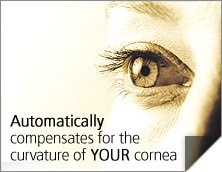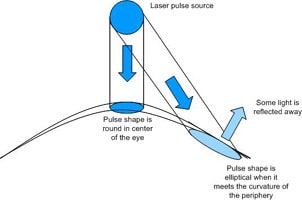
One of the most innovative features of the Allegretto is the way it incorporates wavefront optimization in rendering proper treatment. It is the only vision-correcting laser system that takes into account the starting curvature radius of the cornea being treated. Furthermore, the Allegretto is the only laser system that specifically designs treatment so as to preserve the most normal curvature characteristics (and thereby optimize visual quality) as a consequence of treatment.
In earlier laser systems (treating nearsightedness), the optical zone , or area of correction, was centered on the front of the cornea; the result was a flattened circular area that ended with an abrupt edge, causing unwanted side effects like poor night vision, glare, and halos . Laser treatment patterns (called algorithms) then evolved to apply peripheral treatment in a blend zone around the optical zone.
 There is a problem that arises, however, in treating the peripheral cornea with older laser systems. All prior laser systems are designed to be calibrated on flat plastic test surfaces. However, the cornea is curved, and when treating on the down-slope of the domed surface (everywhere but the top dead center of the dome), some laser energy is scattered rather than being absorbed by the target tissue. This is known as the cosine offset correction problem , as the amount of scattering is proportional to the cosine of the tangent at the point of laser contact. This problem becomes more pronounced the more peripheral the laser aims from “straight down”.
There is a problem that arises, however, in treating the peripheral cornea with older laser systems. All prior laser systems are designed to be calibrated on flat plastic test surfaces. However, the cornea is curved, and when treating on the down-slope of the domed surface (everywhere but the top dead center of the dome), some laser energy is scattered rather than being absorbed by the target tissue. This is known as the cosine offset correction problem , as the amount of scattering is proportional to the cosine of the tangent at the point of laser contact. This problem becomes more pronounced the more peripheral the laser aims from “straight down”.
Imagine a glass ball. If you took a flashlight and aimed it directly at the top of the ball, the light would form a circular shape on the surface of the ball. If you now aimed the flashlight towards the side of the ball, the light would form an elliptical shape and not seem as bright anymore. This is because the same amount of light is distributed over a larger area, and some of the light is reflected away due to the angled surface.
The illustration below demonstrates the need for additional pulses to the corneal periphery, in order to compensate for the energy lost through scattering and reflection.

The Allegretto system, by design, applies extra pulses to the peripheral cornea in order to compensate for the angle of the laser beam. In this manner, the laser anticipates and corrects for any cosine offset issues. In addition, the laser treatment is specifically designed to preserve the naturally aspheric shape of the cornea to a degree that older lasers simply could not achieve. This compensation, combined with the precision of “Perfect Pulse” technology (enhancing the accuracy of tissue sculpting with the precision of laser pulses), produces a smooth, cleanly sculpted optical surface. A good analogy here would be to compare image quality produced by the lens of a small consumer camera (think “old design” laser treatment) to that produced by a high-grade lens a professional photographer might use (think “wavefront-optimized”).
The combination of correction for cosine-offset, plus the aspheric treatment design preserving optimum corneal geometry, plus the “Perfect Pulse” beam technology in aggregate form the basis for the marketing claims of “high performance vision.”